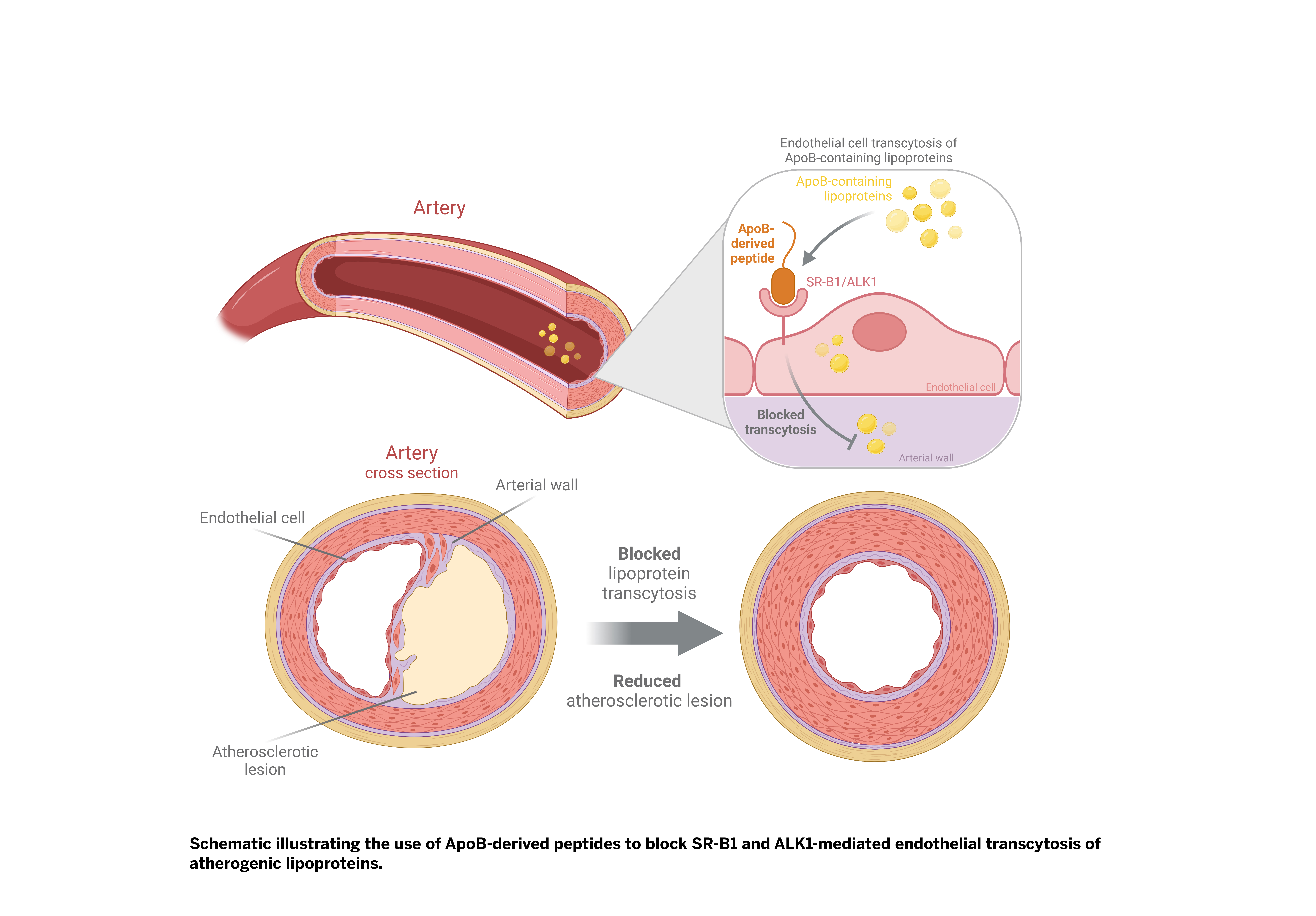Apolipoprotein B Peptide Mimics for Atherosclerosis Treatment
Innovative, efficacious and complementary non lipoprotein-lowering treatments for atherosclerosis.

Technology
The Goldberg Lab, along with colleagues at NYU Health, have recently developed an innovative approach for treating atherosclerosis by blocking receptor-mediated endothelial cell (EC) uptake of atherogenic lipids, such as cholesterol and triglycerides, transported in lipoproteins. They designed peptide mimics of apolipoprotein B (ApoB), an integral structural component of lipoproteins, which retain the receptor binding sites for their cognate EC receptors: scavenger receptor-B1 (SR-B1) and activin receptor-like kinase 1 (ALK1). Such synthetic fragments are expected to mimic the receptor binding activity of full-length ApoB and consequently block binding and subsequent transcytosis of ApoB-containing lipoproteins, such as low-density lipoproteins (LDL) and chylomicron remnants, to arterial ECs. In published and unpublished proof of concept studies (Cabodevilla et al., J Clin Invest 2021), they have shown the current lead ApoB fragment (termed “ApoB18”), containing the N-terminal 18% of full-length ApoB, to effectively disrupt SR-B1 and ALK1-mediated endothelial transcytosis of chylomicrons, LDL and lipoprotein a (Lpa) into the arterial wall (see schematic). Moreover, the researchers have demonstrated that receptor-mediated transcytosis of such lipoproteins induces a typical atherosclerotic inflammatory gene signature in ECs, suggesting that lipoprotein uptake inhibition would be anti-inflammatory and antiatherogenic. Accordingly, in an induced atherosclerosis mouse model, AAV-mediated expression of ApoB18 was found to significantly reduce atherosclerotic lesion size in the aortic root. Together, these findings demonstrate the promise of ApoB peptide mimics for treating atherosclerosis.
Background
The development of atherosclerosis, the cause of most heart disease, is initiated by the infiltration of ApoB-containing lipoproteins into the arterial wall and subsequent recruitment of immune-inflammatory cells. ApoB-containing lipoproteins, such as LDL and chylomicron remnants, bind to the EC receptors SR-B1 and ALK1 to mediate their transcytosis into the subendothelial layer of the arterial wall. Current atherosclerosis treatments predominantly focus on lowering circulating LDL cholesterol levels (e.g., statins, which inhibit enzymatic cholesterol synthesis pathways). Not surprisingly, such treatments can unintentionally hinder the natural physiological processes of cholesterol, thereby carrying adverse side effects. Therefore, alternative and/or complementary, non lipoprotein-lowering treatment strategies are urgently needed. One promising therapeutic avenue is to selectively inhibit the transcytosis of lipoproteins (LDL and chylomicrons) into the arterial wall by blocking the interaction of ApoB with its cognate EC receptors on resident endothelial cells. One lipoprotein of particular importance is Lp(a), an atherogenic particle associated with increased risk of atherosclerosis, thrombosis and aortic stenosis. There are no current treatments for increased Lp(a) and statins often raise circulating levels of this particle. Moreover, cholesterol reducing agents have minimal effects on Lp(a). Our approach has the potential to negate the atherogenic activity of this lipoprotein.
Applications
The treatment of atherosclerosis by blocking endothelial uptake of:
- Chylomicrons
- Low-density lipoprotein
- Lipoprotein a
Advantages
- Unique and targeted approach: Specifically targets the transcytosis of atherogenic lipoproteins within the arterial endothelial cells.
- Reduced risk of side effects: Blocking endothelial cell uptake of lipoproteins likely avoids adverse side effects associated with current therapies modulating cholesterol synthesis.
- Monotherapy or complementary therapy: Could be administered with or without standard-of-care lipoprotein-lowering therapies.
- Method of administration: ApoB fragments could be administered as recombinant polypeptides or in polynucleotide format for viral vector-based expression.
Intellectual Property
A U.S. non-provisional patent application has been filed covering the composition of ApoB mimics and their method of use.
-
expand_more mode_edit Authors (1)Ira Goldberg, PhD, MD
-
expand_more library_books References (1)
- Cabodevilla AG, Tang S, Lee S, Mullick AE, Aleman JO, Hussain MM, Sessa WC, Abumrad NA, Goldberg IJ (Jun 15, 2021), Eruptive xanthoma model reveals endothelial cells internalize and metabolize chylomicrons, leading to extravascular triglyceride accumulation
-
expand_more cloud_download Supporting documents (2)Product brochureApolipoprotein B Peptide Mimics for Atherosclerosis Treatment.pdfMarketing BriefNYU - Apolipoprotein B peptide mimetics for atherosclerosis treatment - Marketing Brief - GOL05-04.pdf (357 KB)